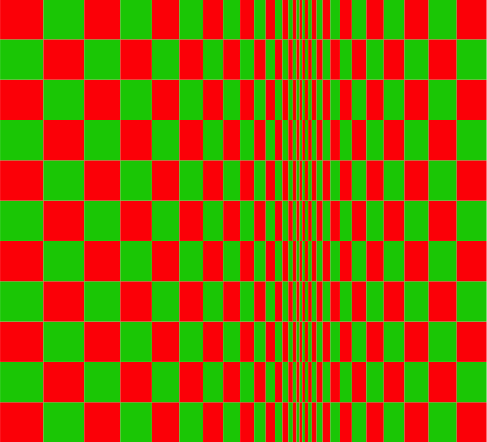
This morning at R-Bloggers I saw Markus’ https://plus.google.com/118201313972528070577/ post, providing R code to produce one of Bridget Riley’s Op Art pictures. Very nice! I played around with it, making it a little more general and adding colour, see attached image for a nearly equiluminant version (the luminance of red and blue are nearly the same), making it even more dynamic. See this paper http://dx.doi.org/10.1068/i0457aap from Johannes Zanker’s lab on eye movements and their role in Op Art pictures. R code below:
Moving SquaRes
Michael Bach 2012-07-12
#
Inspired by
http://lamages.blogspot.de/2012/07/bridget-riley-exhibition-in-london.html
in turn inspired by Bridget Riley’s Moving Squares
distortionFunc <- function(x) { # this is a rounded fit to Markus’ data
return (845x - 46xx +0.88xxx)
}
odd <- function(arg) {
return (arg/2 != round(arg/2))
}
pntsX = 32; pntsY = 12
x = distortionFunc(1:pntsX)
plot(y=x, x=1:pntsX) # for a look at the distortion function
y = 1:pntsY
z = matrix(nrow=pntsX, ncol=pntsY)
for (ix in 1:pntsX) { # I’m sure this could be more elegant in R!
for (iy in 1:pntsY) {
z[ix, iy] = ifelse(xor(odd(ix), odd(iy)), 0, 1)
}
}
cols = c(rgb(0, 0.8, 0), rgb(1, 0, 0)) # nearly equiluminant red&green
image(x[-pntsX], y[-pntsY], z[-pntsX,-pntsY], col=cols, axes=FALSE, xlab=””, ylab=””)
